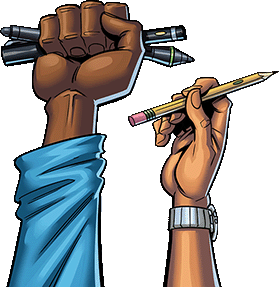What's In A Bind? 4 Types Of Book Binding – Pros And Cons for Comic Printing
September 30, 2020
There are many binding techniques in book publishing, and they vary dramatically in durability and cost. The average consumer only reads fiction works a handful of times, so they don’t need every book they buy to be in hardcover. Instead, most publishers make the bulk of their work available in paperback.
Comic book creators want to balance affordability and durability, but this can be difficult due to comics and graphics novels’ short length. Comic books from major publishers typically use saddle stitch binding. Self-publishing indie creators have multiple options to choose from, especially if their work has a higher number of pages.
If you’re working on printing a comic book or any other graphics-heavy project, it’s important to understand all the methods of binding before placing an order. The quality and your professionalism hinges largely on the type of binding you choose.
Square Binding
As its name implies, square binding creates a flat, squared-off spine. These paperbacks use 60# or heavier interior paper and 80# or heavier paper for the cover, then secure everything together with glue and two small staples or stitching.
The staples inside the binding can sometimes cause small ridges in the spine. Perfect binding is a type of square binding that does not use staples, and instead solely relies upon glue. When done by professionals, perfect binding is durable and will stand up to wear and tear incurred by multiple re-reads.
At Comix Well Spring, our square binding is perfect binding since it does not use staples inside. This creates a clean, smooth spine that looks truly professional. Our square binding is available for page counts of 64 pages or higher.

Saddle Stitch Binding
Saddle stitch binding uses either staples or stitching to bind sheets of paper together. Because of how each sheet of paper ends up creating four pages, saddle stitch bound books can only be made with page counts in multiples of four.
This binding is standard for individual issues of comic books. Each book can either use the same paper as the interior pages for the cover or can use a slightly heavier cover paper.
Saddle stitch books lay flat when opened, which makes them ideal for marketing materials and short catalogs. The staples or stitches will be slightly visible between the middle pages of the book, but this is minor and rarely distracts from the content.
The primary downside of saddle stitch binding is that the more pages it has, the harder it is to bind together. At Comix Well Spring, we can use saddle stitch binding with books up to 68 total pages, including the covers.
Spiral Binding
Workbooks and other books for short-term use sometimes use spiral binding. This inexpensive binding technique winds a plastic or metal spiral through the pages of the book to hold them together.
Although spiral bound books can lay flat on tables, the inside edge of the book’s pages will have small holes in them. This affects the book’s aesthetics and makes it less than ideal for comic books or anything that needs to look professional.
A very similar type of binding is called comb binding. Comb binds are a slightly different shape than spiral binding, but they are generally engineered the same and have the same pros and cons.
Thermal Binding
Although thermal binding also involves glue, it works differently than perfect or square binding. Gluing your pages and cover to the spine requires a special heat-activated piece of tape that runs the length of your book. This tape overlaps with the front and back covers, making it impossible to have a truly seamless cover design.
Thermal binding is available from some printers, and you can even do it at home with the right equipment. However, the resulting binding is somewhat irregular-looking, and you can’t easily print the title of your work on the spine.
The resulting bond might not be as strong as fully-glued perfect binding. If you want to achieve a professional finished look, perfect binding from an experienced comic book printer is your best bet.
What About Hardcover Binding?
Hardcover binding, including traditional case binding, is reserved for long novels and highly-anticipated releases from major publishers because it’s much more expensive than paperback binding. This method uses small, individually-bound sections of about 50 pages each attached inside a hard case. It’s labor-intensive and has a higher material cost than paperback binding.
However, paperback binding is more than sufficient for most books, especially comic books and graphic novels. In the past century, paperback binding has improved significantly, so short paperbacks now hold up to general wear and tear almost as well as case bound books.
Your Partner in Full-Color Printing
Whether you’re printing a graphic novel or just need some short run books for a professional project, count on the team at Comix Well Spring to get the job done right. Our customers love our high-quality printing with vivid colors and multiple customization options.
No matter which of our binding options you choose, we’re here to answer any questions you have about formatting and final printing. Contact our team at (734) 345-6794 to learn more about our printing process and why we’re a trusted partner for so many small businesses and indie creators.


